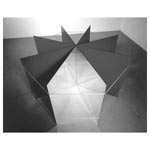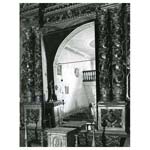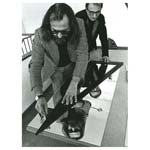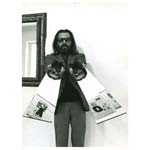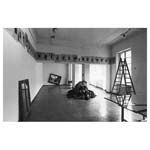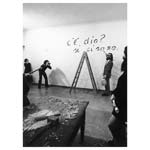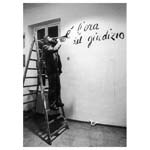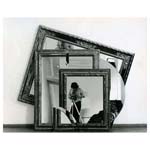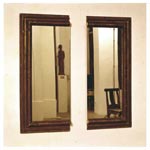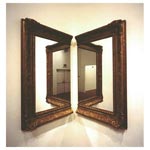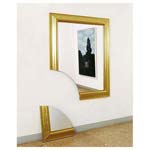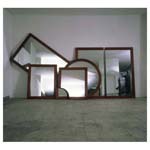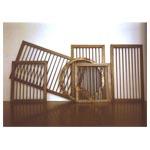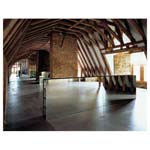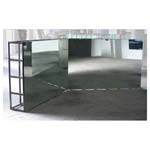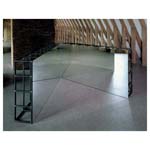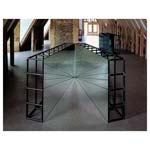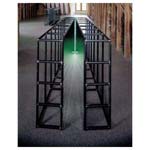In 1977 Pistoletto put a mirror on the altar of the church of San Sicario, a village in the mountains where the artist lives from time to time. A photograph of this action appeared on the poster and the cover of the catalogue of an exhibition called “Division and Multiplication of the Mirror: Art Takes On Religion” [“Divisione e moltiplicazione dello specchio. L'arte assume la religione”], which was held at the Galleria Persano in Turin in March 1978. Through the works shown in this exhibition, the actions and discussions with the public at its opening and two texts published in its catalogue, Pistoletto presented and announced two basic directions in which he was going to take his work.
The first direction, called Division and Multiplication of the Mirror, stemmed from the artist’s realization that a mirror can reflect anything except itself. But by dividing the mirror into two parts and gradually moving the two halves so that they form an angle along the axis of their division, the mirror is multiplied. This phenomenon was at the root of a new series of the artist’s works and activities in which the principle of subdivision was shown to be a universal foundation for all organic growth and, on the social level, for sharing as a logical alternative to accumulation and exclusion.
The second direction, Art Takes On Religion, constituted a first attribution of a central role to art with respect to other fields of human activity and knowledge, something that Pistoletto was to develop later on with his Project Art [Progetto Arte] (1994) and with the founding of Cittadellarte in the nineties. At the same time it was the beginning of a reflection on spirituality that he would return to and explore further in many of his later works and texts.
“I cut the mirror together with its frame, so that the two halves of the frame, sticking to the two mirrors, testified to their original oneness. A series of works and operations on the divided mirror followed in different places and environments, from Corpus Christi in the United States [on the occasion of a visit he paid to Cathleen Gallander, director of the Art Museum of South Texas, in November 1977] to Aalborg in Denmark [a solo exhibition held at the Nordjyllands Kunstmuseum in February 1978]. At the same time, my collaborative work, begun in 1967 with the poster for my studio opening, continued. Thus, the theoretical and factual side of my work proceeded along parallel lines. The mirror stood for the theoretical side, collaboration stood for the factual one. My individuality, compared to the singularity of the mirror, was divided and multiplied when I created with someone else, just as the mirror is divided and multiplied. [...]
At San Sicario I placed a mirror, where usually there was a painting, in a baroque frame on the altar of the church. Thus, just as in the early sixties I replaced canvas with mirrors on the walls of houses, art galleries, and museums, here, I replaced the canvas on the altar with a mirror. [...] At the beginning of our century, the avant-garde made art again autonomous. Art ceased to be a symbol of religious and political power, but it is still far from the people, because its autonomy regards only its aesthetic side. Now art must find autonomy for its factual side as well [...] ‘Art takes on religion’ means that art actively takes possession of those structures, such as religion, which rule thought; not with a view to replacing them itself, but in order to replace them with a different system of interpretation, a system intended to enhance people’s capacity to execise the functions of their own thought.”
(M. Pistoletto, Divisione e moltiplicazione dello specchio – L’arte assume la religione, Galleria Giorgio Persano, Turin 1978).
In 1978 Pistoletto began a year-long residency at the DAAD [German Academic Exchange Service] in Berlin. During this time the Nationalgalerie showed a group of his Mirror Paintings interspersed with works from the museum’s permanent collection. Thirteen of his other works were scattered around the same number of public places in the city. In addition to the officially announced locations, Pistoletto staged an exhibition, entitled An Island in Time, at the Galerie Schweinebraden in the Eastern sector of the city. Pistoletto turned up for the opening of this exhibition on the other side of the Wall that divided the city at the time dressed as a 17th-century gentleman. Here he showed the work The Lecture (1975) and drew the image of a bridge. Called I Am the Bridge [Ich bin die Brücke], it would be used as the logo of the Creative Collaboration project carried out by Pistoletto in the United States the following year.
